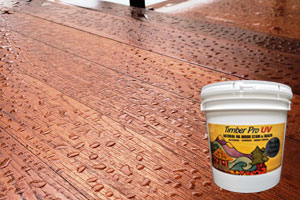Deck & Fence Maintenance Guide
Timber-Pro UV is a hard-drying, penetrating and bonding finish made from plant oil resin. The finish will “bead” water initially until it is well cured and rainproof. From that point on it will “sheet” water rather than bead water. Keep the deck clean with an occasional light power washing or mild wood cleaner such as Clean & Brite.
DO NOT USE BLEACH-BASED CLEANERS!
Mildew only forms on dirty wood. As a rule of thumb, deck stains need to be refreshed yearly. Occasionally, every other year is okay if your stain is holding really well but at least clean the deck in the interim year. Usually one liberal coat is sufficient for a maintenance coat, unless you have a lot of sun or wear on your deck. If you see a gleam on the wood after the first maintenance coat you should not apply a second maintenance coat. Fences, being vertical surfaces require less frequent maintenance coating. If you applied two coats originally you should re-apply a coat or two every four to six years after a good cleaning.
Snow is a deck stains worst enemy!
For those of you who live in areas where snow is likely to fall on your deck, snow left to accumulate causes problems. You could end up with a situation where water is actually being “pressure treated” into the wood. Snow melts from the bottom up so the wetness is next to the stained wood with heavy snow on top of it. Just about every deck board has minute cracks and the weight of the snow on the water is forcing moisture into these cracks where it insinuates into the wood underneath the stain. The water will then push the stain off from the inside out. Try to keep your deck swept (not shoveled) free of snow at all times to avoid this possibility.
Holding the Color – The tint in Timber-Pro UV lays mostly on surface fibers to act as a layer of sunscreen. Tint will eventually begin to break down and fade. Examine your deck periodically for fading. Before noticeable fading occurs, clean deck with Clean & Brite and apply a maintenance coat. If you wait too long, the surface will significantly lighten and then gray. You may notice that in the more protected areas of the deck (under a covered section, or under the house eaves) the finish has not worn. When applying a maintenance coat on the more weathered areas, feather into the areas where the stain has not worn rather than just applying more stain where it isn’t needed.
Gray Streaks? Keep your eye on the flat grain portion of your deck and fence boards. The finish will wear faster on the flat grain (very wide apart grain lines and scalloped grain pattern areas) and if you wait too long to re-apply the flat grain area will fade to gray. The deck boards that have grooves cut lengthwise on the underside of the board are very flat grained and this type of decking is maintenance intensive! You will have to treat every year because this type of cedar is resistant to penetrating sealers. If you do have multiple gray areas you would need to strip the deck with Strip & Brite and remove all the stain and discoloration and then start over again with a fresh, stripped back to bare deck. This is why it saves effort in the long run to maintain your deck on a regular basis.
NEW DECKS or Exotic Wood Decks will need to be re-coated more often. New wood will not absorb as much stain as a seasoned deck so they need more consistent coating applications until they are seasoned and start absorbing product better. Your new wood deck may need to be single coated every 12 months for the first 3 years, and should be treated every 24 months. Exotic Wood Decks (new or old) will probably need re-coating every year due to the density of the wood, it just doesn’t soak up much stain.




